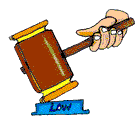There are many ways to classify laws, but to narrow things down the law is divided into two broad categories — criminal law and civil law.
 To make it easy, civil law is all law other than criminal law, such as property law, which governs transfer and ownership of property, and contract law, which is the law of personal agreements; doesn’t that make things so much clearer? When a person has a grievance and it can’t be settled any other way, than an action has to be taken were the courts will settle the differences. This type of law is called a tort law and it’s a civil action in which an individual asks to be compensated for personal harm done to him or her. The harm may be either physical or mental and includes such wrongful acts as trespassing, assault and battery, invasion of privacy, libel (false and injurious writings against you), and last but not least, slander (false or injurious writings).
To make it easy, civil law is all law other than criminal law, such as property law, which governs transfer and ownership of property, and contract law, which is the law of personal agreements; doesn’t that make things so much clearer? When a person has a grievance and it can’t be settled any other way, than an action has to be taken were the courts will settle the differences. This type of law is called a tort law and it’s a civil action in which an individual asks to be compensated for personal harm done to him or her. The harm may be either physical or mental and includes such wrongful acts as trespassing, assault and battery, invasion of privacy, libel (false and injurious writings against you), and last but not least, slander (false or injurious writings).
Torts happen when someone is injured by the actions of another. Remember O.J. Simpson, who was found “not guilty” during his criminal trial, but was found “guilty” during his civil trial? This discrepancy happens because the standard of evidence for a finding is less in civil cases. Criminal trials are based on the evidence of “beyond a reasonable doubt”, while for a civil case the evidence has only to prove the “preponderance of the evidence.
A violation of civil law may also happen when a behavior indirectly causes injury that starts a chain of events that end in d–th. Some torts are similar to criminal acts and that is why a person can be held on both counts. For example, if one man hits another in the mouth, it is possible for the assailant to be charged by the state with assault and battery, be imprisoned, plus be sued by the victim in a tort action of assault in which the attacker will have to pay the victim for the damages he caused. An important similarity between criminal law and civil law is they have a common purpose, and this is to control people’s behavior by setting limits on what acts are permissible in this country.
The main purpose of criminal law is to give the state the power to protect the public from harm by punishing individuals whose actions threaten the social order of things. In tort law, the harm or injury is considered a private wrong, and the main concern is to compensate the victim for the harm that was inflicted on them. For criminal actions, the state initiates the legal proceedings by bringing charges against the criminal, then prosecuting him or her.
Once it is determined that a criminal law was broken, the state will then proceed to impose a sentence against the defendant such as imprisonment, probation, or a fine, payable to the state. In civil actions, the injured person must file an action in order to initiate proceedings, if the offender is found guilty, then he or she must pay restitution to the person that was harmed. Of all cases, criminal or civil laws that are brought up on charges, only 10% of these charges actually go to trial and are heard in front of a judge or jury. Most cases are settled out of court, by both parties coming to an agreement that they both can live with.
This page will be verymuch useful for law students and advocates enetering into practice.